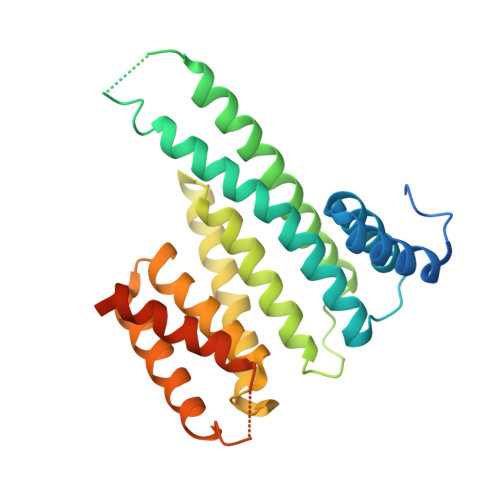Identification of Phosphate-Containing Compounds as New Inhibitors of 14-3-3/c-Abl Protein-Protein Interaction.
Iralde-Lorente, L., Tassone, G., Clementi, L., Franci, L., Munier, C.C., Cau, Y., Mori, M., Chiariello, M., Angelucci, A., Perry, M.W.D., Pozzi, C., Mangani, S., Botta, M.(2020) ACS Chem Biol 15: 1026-1035
- PubMed: 32142251
- DOI: https://doi.org/10.1021/acschembio.0c00039
- Primary Citation of Related Structures:
6TLF, 6TLG, 6TM7 - PubMed Abstract:
The 14-3-3/c-Abl protein-protein interaction (PPI) is related to carcinogenesis and in particular to pathogenesis of chronic myeloid leukemia (CML). Previous studies have demonstrated that molecules able to disrupt this interaction improve the nuclear translocation of c-Abl, inducing apoptosis in leukemia cells. Through an X-ray crystallography screening program, we have identified two phosphate-containing compounds, inosine monophosphate (IMP) and pyridoxal phosphate (PLP), as binders of human 14-3-3σ, by targeting the protein amphipathic groove. Interestingly, they also act as weak inhibitors of the 14-3-3/c-Abl PPI, demonstrated by NMR, SPR, and FP data. A 37-compound library of PLP and IMP analogues was investigated using a FP assay, leading to the identification of three further molecules acting as weak inhibitors of the 14-3-3/c-Abl complex formation. The antiproliferative activity of IMP, PLP, and the three derivatives was tested against K-562 cells, showing that the parent compounds had the most pronounced effect on tumor cells. PLP and IMP were also effective in promoting the c-Abl nuclear translocation in c-Abl overexpressing cells. Further, these compounds demonstrated low cytotoxicity on human Hs27 fibroblasts. In conclusion, our data suggest that 14-3-3σ targeting compounds represent promising hits for further development of drugs against c-Abl-dependent cancers.
Organizational Affiliation:
Department of Biotechnology, Chemistry and Pharmacy-Department of Excellence 2018-2022, Università degli Studi di Siena, via Aldo Moro 2, 53100 Siena, Italy.
















